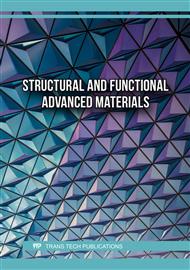[1]
W. Sha, Z. Guo, Maraging Steels, Woodhead Publishing, (2009).
Google Scholar
[2]
F. Habiby, A.ul Haq, A. Q. Khan, The properties and applications of 18% Nickel Maraging Steels, Materials Technology, 9 (1994) 246-252.
DOI: 10.1080/10667857.1994.11785084
Google Scholar
[3]
M. N. Rao, Progress in understanding the metallurgy of 18% nickel maraging steels, International Journal of Materials Research, 97 (2006) 1594-1607
DOI: 10.3139/146.101418
Google Scholar
[4]
B. Rihit, N. R. Muktinutalapati, Fatigue Behavior of 18% Ni Maraging Steels: A Review, Journal of Materials Engineering and Performance, 30 (2021) 2341–2354.
DOI: 10.1007/s11665-021-05583-w
Google Scholar
[5]
W. Wang, W. Yan, Q. Duan, Y. Shan, Z. Zhang, K. Yang, Study on fatigue property of a new 2.8GPa grade maraging steel, Materials Science and Engineering A, 527 (2010) 3057-3063.
DOI: 10.1016/j.msea.2010.02.002
Google Scholar
[6]
L. pollock, A. K. Abdelwahab, J. Murray, G. Wild, The Need for Aerospace Structural Health Monitoring: A Review of Aircraft Fatigue Accidents, International Journal of Prognostics and Health Management, 12 (2021) 1-16.
DOI: 10.36001/ijphm.2021.v12i3.2368
Google Scholar
[7]
B. Zhao, J. Song, L. Xie, H. Zhiyong, C. Jianpeng, Surface roughness effect on fatigue strength of aluminum alloy using revised stress field intensity approach, Scientific Reports, 11 (2021) 19279.
DOI: 10.1038/s41598-021-98858-0
Google Scholar
[8]
T. Childerhouse, R. M'Saoubi, L. Franca, N. Weston, O. Crawforth, The influence of machining induced surface integrity and residual stress on the fatigue performance of Ti-6Al-4V following polycrystalline diamond and coated cemented carbide milling, International Journal of Fatigue, 163 (2022) 107054.
DOI: 10.1016/j.ijfatigue.2022.107054
Google Scholar
[9]
M. Kattoura, A. Telang, S. R. Mannava, D. Qian, V. K. Vasudevan, Effect of Ultrasonic Nanocrystal Surface Modification on Residual Stress, Microstructure and Fatigue Behavior of ATI 718Plus Alloy, Materials Science and Engineering A, 711 (2018) 364-377.
DOI: 10.1016/j.msea.2017.11.043
Google Scholar
[10]
D. Kumar, S. Idapalapati, W. Wei, Microstructural Response and Strain Hardening in Deep Cold Rolled Nickel based Superalloy for Aerospace Application, Procedia CIRP, 71 (2018) 374-379.
DOI: 10.1016/j.procir.2018.05.044
Google Scholar
[11]
JIS B 2711, Shot Peening, (2005).
Google Scholar
[12]
H. Soyama, Comparison between the improvements made to the fatigue strength of stainless steel by cavitation peening, water jet peening, shot peening and laser peening, Journal of Materials Processing Technology, 270 (2019) 381-382.
DOI: 10.1016/j.jmatprotec.2019.03.008
Google Scholar
[13]
T. Tsuji, M. Fujino, K. Takahashi, Fatigue Limit Improvement and Rendering Surface Defects Harmless by Shot Peening for carburized Steel, Metals, 13 (2023) 42.
DOI: 10.3390/met13010042
Google Scholar
[14]
K. W. Nam, M. H. Kim, K. H. Gu, C. Y. Park, Rendered Harmless of Surface Crack with Different Crack Aspect Ratio in Ultrasonic Peened STS316L Steel, Trans. Korean Soc. Mech. Eng. A, 45 (2021) 629-635.
DOI: 10.3795/ksme-a.2021.45.8.629
Google Scholar
[15]
M. H. Kim, W. G. Lee, C. S. Kim, K. Takahashi, M. Handa, K. W. Nam, Evaluation of Fatigue Limit and Harmless Crack Size of Needle Peened Offshore Structure Steel F690, Journal of Mechanical Science and Technology, 35 (2021) 3855-3862.
DOI: 10.1007/s12206-021-2109-4
Google Scholar
[16]
S.H. Park, K.H. Gu, G.H. Lee, K.W. Nam, Evaluation of Harmless Crack Size of A6061-T6 for EV Battery Pack Case," Trans. Korean Soc. Mech. Eng. A, 47 (2023) 417-425.
DOI: 10.3795/ksme-a.2023.47.5.417
Google Scholar
[17]
S. Tsuchiya, K. Takahashi, Rendering Defects Harmless through Laser Peening in Additive Manufactured Maraging Steel, Metals, 12 (2022) 49.
DOI: 10.3390/met12010049
Google Scholar
[18]
A. Casagrande, G. P. Cammarota, L. Micele, Relationship between fatigue limit and Vickers hardness in steels, Materials Science and Engineering A, 528 (2011) 3468-3473.
DOI: 10.1016/j.msea.2011.01.040
Google Scholar
[19]
M. Nakagawa, K. Takahashi, T. Osada, H. Okada, H. Koike, Improvement in fatigue limit by shot peening of high-strength steel containing crack-like surface defect (infuence of surface crack aspect ratio), Jpn. Soc. Spring Eng., 2014 (2014) 13-18.
DOI: 10.1115/pvp2013-97839
Google Scholar
[20]
J.C. Newman Jr, I.S. Raju, An empirical stress-intensity factor equation for the surface crack, Engineering Fracture Mechanics, 15 (1981) 185-192.
DOI: 10.1016/0013-7944(81)90116-8
Google Scholar
[21]
American Petroleum Institute, Recommended Oractice579, Fitness for Service, American Petroleum Institute, (2000) C3-C10.
Google Scholar
[22]
K. Ando, R. Fueki, K. W. Nam, K. Matsui, K. Takahashi, A Study on the unification of the threshold stress intensity factor for micro crack growth, Japan Society of Spring Engineers. 64 (2019) 39-44.
DOI: 10.5346/trbane.2019.39
Google Scholar
[23]
H. Kitagawa, S. Takahashi, Applicability of fracture mechanics to very small cracks or the cracks in the early stage, In: Proc. 2nd Intern. Conf. Mech. Behav. Mater., Boston, ASM, Cleveland, Ohio, (1976) 627-631.
Google Scholar
[24]
A. Tange, T. Akutu, N. Takamura, 1991, "Relation between shot-peening residual stress distribution and fatigue crack propagation life in spring steel", Transactions of JSSE, 1991 (1991) 47-53.
DOI: 10.5346/trbane.1991.47
Google Scholar


